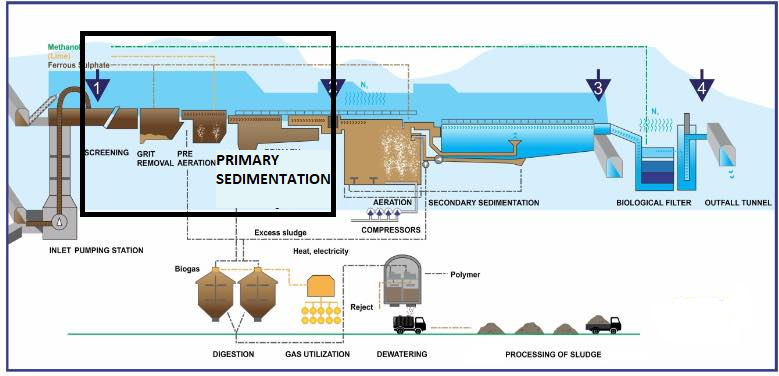Select Your Country/Region
Current Region:
 USA (EN)
USA (EN)
Choose a different country or region to see the content specific to your location
- Industries and Applications
- Wastewater Blowers
- Primary Sedimentation
Current Region:
 USA (EN)
USA (EN)
Choose a different country or region to see the content specific to your location
Primary sedimentation is a process used in the wastewater treatment industry. It occurs after the water passes through the screening process where all non-organic solids such as non-dissolved materials, wet-pipes and debris are removed from the water.
Primary sedimentation removes suspended solids and floating organic material that enters a wastewater treatment plant from a sewage system. At this stage, sewage flows through large primary sedimentation tanks. Primary treatment will have little effect on pathogens in the liquid waste stream. It only gives water or wastewater a primary degree of purification.
Secondary treatments usually follow the primary treatment. These methods use a trickling filter, activated sludge or a chemically enhanced treatment. They are used when pathogens and fecal matter are high in concentration. At this time, viruses, bacteria, and protozoa are removed at a high rate to produce drinkable water.

The primary sedimentation tank is put into action in the final part of the preliminary sedimentation treatment. This is where untreatable solids that first enter a wastewater treatment plant from the sewer are removed.
A sedimentation tank, also called a settling tank or clarifier, is used to settle suspended particles in water. This is achieved as the wastewater or water usually passes slowly at variable speeds through the tank. A layer of sludge settles at the bottom of the tank and is periodically removed.
The tanks settle sludge while the grease and oil rises to the surface and is skimmed off. Primary settling tanks are usually equipped with mechanically driven scrapers. These drive the collected sludge continually towards a hopper in the base of the tank. From here, it is pumped to treatment facilities using blowers or similar technologies. As a result biological materials remain on the surface and the heavy components (sludge) sink to the bottom to be isolated.
Afterwards, water is sent into an aeration tank to begin phase two. The secondary stage uses biological processes to further purify wastewater. Sometimes there is a tertiary phase when additional chemical treatment may occur.
The rate of wastewater flow is reduced dramatically before entry into the primary sedimentation tanks. This has two effects on the wastewater:
1. Fats, oil and greases (commonly known as FOG) float to the surface of the sedimentation tank. These are collected by a scraper bar which continuously rotates across the surface of the tank. The FOG is removed from the wastewater and disposed of.
2. Organic solids are heavier than water and due to the effects of gravity fall to the bottom of the tank. Once they reach the bottom of the tank, the sediment (often referred to as sludge) is collected by a rake arm. It is moved to a nearby storage tank (similar process as point (1) above).
At this stage the sediment is a concentrated mix of water solids with a high content of HS2, methane and bacteria. At this point the sludge reprocessing process begins. The wastewater, which is now virtually solid free and considerably cleaner, enters the aeration stage of the process. Here, small organic particles that cannot be affected by gravitation in the sediment tanks and ammonia are removed.
The majority of the sedimentation process that occurs in tanks is of a mechanical nature. The aim is to keep the wastewater moving (at various speeds) from the beginning to the end of the process. Still, some portions of the water remain in a static state. They can cause a build-up of solids that create blockages and sedimentation problems for the mechanical equipment used in the treatment process. To alleviate this, small amounts of air are introduced into the process to move the water along mechanical surfaces or submerged mixers. In some cases, chemical dosing is also used to help break down the sludge.

Lobe and side channel blowers are often and successfully used in the primary sedimentation stage to clear sand and grit from various mechanical equipment. They are a perfect fit for sedimentation tanks as well as other grit/sand removal devices used in primary sedimentation.
These blowers introduce small concentrated amounts of air in the form of coarse bubble aeration. These bursts are used for short periods of time to clear clogs caused by sand and grit. Side-channel or small lobe blowers feature low energy consumption and are well suited for application in primary sedimentation.
They are rugged, compact for easy installation, and offer very low maintenance. Side-channel blowers are a relatively new technology that can easily be implemented into small spaces due to their small size. They are a perfect fit for Wastewater and Water Treatment applications where air pressure is needed at various process locations. Lobe blowers have been utilized for a few decades and have proven to stand out in Wastewater and Water Treatment applications. They are larger units than side-channel blowers and fit for installation in larger primary sedimentation tanks.

